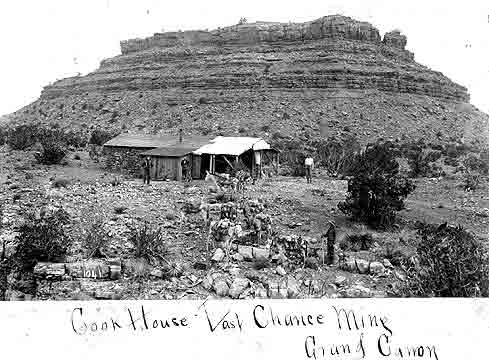At the end of the Grandview Trail, in an area where the Hopi once gathered blue copper ores that they used for paint, Euro-American entrepreneurs would establish one of the few successful mining operations at the Grand Canyon. Here, on Horseshoe Mesa, Pete Berry and his partners including Niles and Ralph Cameron and Ed Gale, established Last Chance Mine to more fully exploit these productive copper veins.
From 1893-1907, eight to ten mules steadily made about a trip and a half each day, from Horseshoe Mesa to Grandview Point and back. Each mule hauled 200 pounds of sorted copper ore up from the mine, and food and other supplies back down the steep trail. Ore carried out of the mine was stored at the rim until a significant pile had been accumulated, then transported to the nearest railroad. Early on, this would have been more than 60 miles away at Flagstaff; after 1901, they brought the ore to the Santa Fe Railroad spur at Grand Canyon Village a few miles west. By the time the mine closed in 1907, hardworking mules had carried enough copper ore out of the mine and up the Grandview Trail to fill 140 railroad carloads. This ore was transported to El Paso, Texas, for processing. Altogether, it is estimated the mine produce about $75,000 worth of copper. Miners earned about $4 per day plus meals. From 1902-1907, the crew averaged 5 men, though the camp could accommodate 25.
The Last Chance Mine (and its seven adjacent claims) was one of the few at the Grand Canyon that was relatively profitable, producing hundreds of tons of high-grade copper ore. At the 1893 World’s Fair in Chicago, ore from the mine won a top prize for its purity. By 1895, the mine was so successful that Berry and the Cameron brothers incorporated their business as the Grand Canyon Copper Company. At the same time, a stagecoach company started ferrying visitors from Flagstaff to this point along the South Rim, a 12-hour ride. Berry would personally lead excursions down the Grandview Trail to Horseshoe Mesa, and sometimes all the way to the Colorado River.
Overhead costs, including keeping the trail maintained, were too much for the small mining business to absorb. In 1902 they sold their interests to a group of Vermont businessmen who renamed it the Canyon Copper Company. They constructed a mill site at the modern Grandview Trailhead that crushed the ore from the Last Chance Mine before it was shipped away. The company continued working the mine until 1907, when copper prices plummeted and the mine closed forever.
By 1965, visitors to the old mine site on Horseshoe Mesa could still see one cabin made of stone and wood with a metal roof, which collapsed a few years later. East of this were the rotting remains of several tent cabins, plus a mine cart, metal wheelbarrow, picks, shovels, and drills. Most of these remnants are gone now, although visitors can still find artifacts from the mining period, including mine shafts, an ore crusher, and ore carts. An ancient Native American ruin is also visible nearby. The Grandview Mining District on Horseshoe Mesa has been listed on the National Register of Historic Places. It is protected by federal law and should be enjoyed but not disturbed.
Written By Sarah Bohl Gerke
References:
- Anderson, Michael F. Living at the Edge: Explorers, Exploiters and Settlers of the Grand Canyon Region. Grand Canyon Association, 1998.
- Anderson, Michael F. Polishing the Jewel: An Administrative History of Grand Canyon National Park. GCA, 2000.
- Billingsley, George H., Earle E. Spamer, and Dove Menkes. Quest for the Pillar of Gold: The Mines and Miners of the Grand Canyon. GCA, 1997.
- “Grandview Trail and Horseshoe Mesa.” Grand Canyon National Park. 2006.
- Stampoulos, Linda L. Visiting the Grand Canyon: Views of Early Tourism. Charleston, SC: Arcadia Publishing, 2004.




